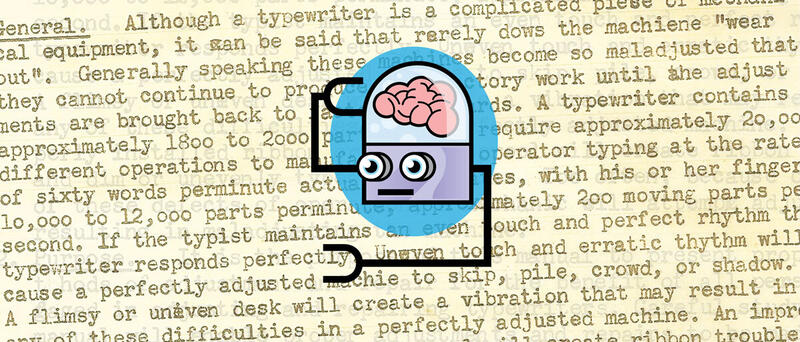
Let’s future proof of digital memory by tracking the articles we read.
A lot of what we read today are internet articles. We rarely read physical newspapers. Instead, we consume information from our computers, phones, tablets and e-readers. It has all become digital or a lot of it at least.
Because so much of what we do is connected to the digital via devices and sensors, we can conceivable track everything. From steps, heart rate, sleep, and food to time, place and mood, it’s getting easier and easier to self-track. Socrates’ challenge to “know thy self” now has concrete data to base that philosophical survey upon.
Like the books we read, the articles we read constitute an intimate portrait into our mental lives. Whether you are consuming all the latest gossip or the upcoming IPO and tech gadgets, what you read is a significant portion of how you think of yourself. Like movies and music, articles and books are the backdrop upon which a thinking person exists.
Fortunately, for the self-tracker and knowledge worker, it’s easy to capture and track the things you read. With a few tools and simple processes, you can keep track of all the articles you read. You can know exactly how much and what you’ve read over time. Equally you can start to develop what I call your “digital memory” or “digital archive.”
In this post we are going to look at few tools (like Pocket and Evernote) to track what you read. All of these applications provide a way of storing articles to “read later.” By being disciplined about checking-in articles you read now on a browsers, these tools can be used to record the all articles you read. Or, if you prefer, all the key articles you read.
Furthermore, by tweaking your approach and setting up a few additions, you can measure your article reading. You can know how articles you read each week. If self-improvement or just reading more is one of your missions, you can aim to increase this number.
Update (8/9/19): Check out my updated guide on Instapaper, my current favorite tool for saving and tracking the online: Instapaper: Empowering How I Read Articles with Highlights and Tracking.
Why Track What You Read
![]()
The main reason why someone uses tools like Pocket, Evernote or Instapaper for article reading is that are dealing with a cluttered internet. Filled with distractions and competing attention for our work and attention, we use these tools to bookmark things to read later. These tools help us deal with information overload.
The side benefit of using these “read it later” applications for your digital reading is that you have your own record of what you are reading.
While services like Facebook and Google have a considerable amount of data on netizens, they don’t provide much of that data back. Google is a bit better and there are ways to access your browsing history.
For me using these read it later tools allows me to create a digital memory back to complement to my biological one. This is part of the on-going trend to augment human capacities. We use computers to enhance our computing capacity. We leverage the internet to open access to a nearly infinite amount of information, news and knowledge.
By adding a digital memory to enhance your biological one, you can remember (or at least access) more and with greater detail. In fact, this for me is one of the goals of self-tracking: a past data-driven journal to what, where and how I was in any moment in my past.
If you are organized and disciplined and mostly read in digital, you can create a repository of articles and be able to look back and find any important article you’ve read and the key points you’ve highlighted.
Let’s look at two tools that help.
Pocket: “Read It Later” to Know What You Read
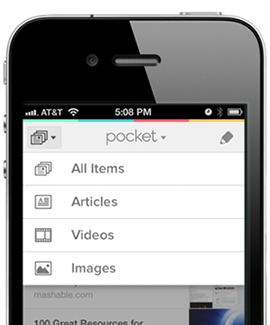
Pocket was one of the first tools on the web to help you manage your digital reading. With so much distraction and multitasking, Pocket or “Read It Later” as it was originally called made it easy to convert urls into articles to consume later. They stripped content of the advertisements and distractions to present easy to read content.
You simply loaded content using their browser extension and read it later either via their web version or their mobile app. It was a great experience to read articles in a more focused way.
Pocket was a real game changer for me when it first appeared. Suddenly I could avoid distraction while I worked when I discovered something I wanted to read. All I had to do was save it to Pocket and read it later. This made it easier to read more while also doing it in a focused session.
Pocket once a year also offered at some interesting stats on your reading. While it’s impossible to know how they calculate this number. Are they actually counting words? Doing averages? How is this number generated?
Here is mine in 2015.
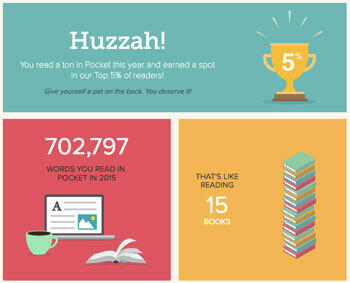
While this yearly total is nice pat on the back, it wasn’t that actionable or insightful for me. I started using Pocket in 2013, which was around the same time I also doing Weekly Reviews. Along with logging my computer usage time (RescueTime) and steps (Fitbit), I was logging how many articles I read each week in Pocket.
Since at the time Pocket didn’t offer any weekly or daily stats, my method to track this number was simple. I’d use their export function to get all of my article titles and links and then calculate the difference in the total read. It wasn’t perfect but it got me a number.
Similarly having logged all of my reading into Pocket, I could look back and see my favorite pieces too. So, during my review, I’d glance at what I’d read and add a note on a few of my favorite pieces.
Pocket remains one of the best tools out there for reading articles. It’s simple bookmarking tools in web and mobile makes it easy to collect things to read. It’s mobile and web apps provide for great, distraction-free reading. I also love their periodically emails on the most popular content on the web from their readers.
Unfortunately, Pocket existed in a separate system. I could calculate stats and have an enjoyable reading experience, but it was separate from most of my writings, notes and important docs. This meant the articles I read where searchable or connectable to my writings, research and thoughts. This is why I shifted to Evernote.
Evernote: My Preferred Tool and Method for Tracking the Articles I Read
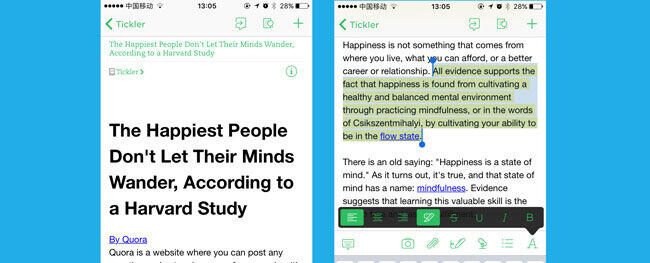
Evernote remains one of my core productivity tools. I mainly use it as my digital filing cabinet. So all my digital knowledge gets stored there. I also use Evernote in a lot of others ways, including as a task manager, a daily journal, a goal tracker, a writing tool, and a [personal CRM]. While a number of other tools with a similar “note taking” focus have appeared, Evernote remains my tool of choice.
Even though I started with Pocket as my primary non-browser application to read articles, eventually Evernote took on this role simply because it was already handling so much of my digital information life. It proved easy to use for reading and, with tagging I could also track my total number of articles read.
So, how do I use Evernote as a article reading tool? What features do I use to help me read? And how do I track how much I read during a period?
A complete introduction to Evernote goes beyond this post. But to summarize, Evernote is a computer, mobile and web application that lets you collect different pieces of information and store them in “notes.” Primarily focused on text information, Evernote can also embed photos and attach other document types. Evernote’s power and flexibility comes from its tagging system which allows you to use notebooks and tags to create well-organized knowledge storage system. It’s a digital journal interconnected with everything.
Evernote has a number extensions that help you bring web and other information into it. When it comes to reading articles, Evernote has a great browser extension called “Evernote Web Clipper.” Using the Clipper, you simply click the button, optionally configure and then sync the article to Evernote. After that you can read the content via Evernote, either on your desktop computer or via their mobile app. The “Web Clipper” is how I save articles to read later or log articles I’ve just read.
In order to keep things organized, I have created a number of notebooks and tagging conventions for my different manners of using Evernote. So, for example, I have a CRM-specific notebook for my contacts and use tags to note where someone is located and industry they are involved in.
When it comes to using Evernote as an article reading tool, I have a simple process: new articles go into a tagged notebook and when I’m done reading it goes to a different cabinet with the “read” tag.
To be more specific: New items from article reading are imported via the Web Clipper into a unique notebook I have created called “Tickler.” You could call it “Read It Later.” All my new articles to read are stored here, and I attach a tag called “Article” to each item. This makes it easy to see how many items I have still to read in the Tickler file and I can look at how many total articles I have using that Tag. Furthermore once I’ve read an article, which I typically do on my mobile phone, I simply move that item from the Tickler to the Cabinet where all my reference articles and notes are stored.
When it comes to reading itself, Evernote is not the most optimized for reading. Admittedly Pocket and Instapaper do a better job with presenting content in clean and distraction-free manner. Evernote also serves more as a note taking tool rather than reader, so it’s UI is not surprisingly more cluttered with additional tools. That said, Evernote does an extremely good of keeping things minimalistic. Personally I don’t have any issues reading my articles on Evernote.
Beyond the reading, Evernote has a simple highlight function. This makes it possible for me to highlight key passages in the articles I read. I’m also able to add notes anywhere and everywhere. Further enhancing things I can add tags to help categorize content, and once I start using content in writing and research, it’s easy to cross-reference note article directly via internal links.
Reading Tracking and Stats with Evernote
So, what about tracking? what about reading statistics?
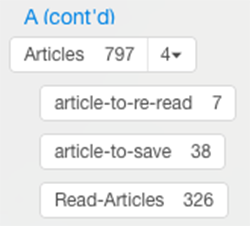
I’ll admit that Pocket and Instapaper make it easier to count how many pieces of content you read. Since both tools essentially group content as “to be read” and “read,” it’s simple to calculate how many articles you’ve read. Fortunately using tags and a simple process, it’s easy to know how many articles you’ve read in a period.
Here is how I do it: By first importing articles into my Tickler file with the “Article” tag, I’m easily able to know how many articles I have in total (i.e. all notes tagged with “Article”) and how many I have still to read (i.e. all articles in the Tickler notebook).
In order to know how many articles I have already read, I can either do a bit of math to calculate this number. But even easier is to do a quick search by notes tagged “Article” in the Cabinet Notebook and then bulk update them all with “Articles-Read” tag. Using the tag section or sidebar shortcut, I can see my total articles read at a glance.
Since each week I do a weekly review, I simply log this data point into a note for tracking this over time.
With Evernote I’m able to get the tracking data point I want along with a strong end-to-end solution of reading, storing and leveraging digital information and knowledge. All of my articles end up in one place and, even if I don’t tag everything perfectly, all my content is searchable. Instead of leaving all of my information in a dozens of tools, I have Evernote as my main knowledge repository.
Whether I’m studying some software dev bug, learning a new language or studying some one-off topic, all that knowledge and reading goes into Evernote now.
So, how does this future proof me for the next evolution of digital knowledge?
Conclusion: Future Proof Your Reading, Augment Your Digital Memory
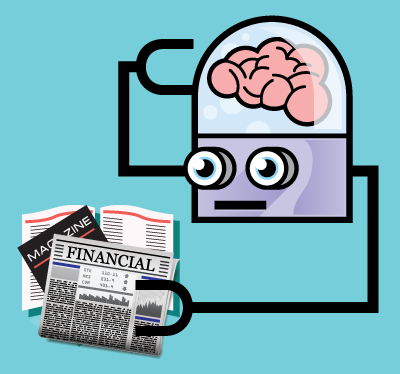
I believe that one day we will be directly connected to a computer on a neurological level. Projects are our already underway to make this happen. There are already multiple companies and universities working on brain-computer interfaces. For example, it was reported in Fast Company piece that a fully “locked-in” patient with Lou Gherig’s disease had become the “first patient to use a brain-computer at home, without help.” Without a doubt more of this will be coming.
We already live in a period where much of our biological capacities are augmented by technology. We drive or ride cars to move faster. We use airwaves and internet connections to communicate across space almost instantly. And we use our phones and computers as tools to augment our mental and thinking capacities. Our smart phones are an extension of us, allowing us to access an internet’s worth of information and utilize a myriad of computation capacities.
We live in the age of digital information and digital reading. This creates challenges like addiction to social media and our phones. We are bombarded by endless ways to be distracted and entertained. It’s hard to avoid losing time in various distracted mental states.
That said, there is a lot of powerful technology helping us to live better and more productivity. I use a lot of these tools and continue to try, tweak and leverage them for self improvement.
When it comes to reading and tracking my article reading, I’ve used Pocket for many years. It does a great job of bookmarking content for later consumption. Recently I switched to Evernote since I was able to get much of them functions as Pocket while keeping articles in my primary information system, Evernote. There were a few trade-offs, but overall I’ve been able to track how many articles and get everything stored in a single, searchable system.
You can never be sure about how long any tool will last. Evernote and other tools may one day cease to exist as viable companies. Fortunately I’m sure that the data I’ve built and collected can be exported and transferred to future tools.
Furthermore as we advance towards greater interaction and connectivity between humans and computers, I’m already preparing. My reading is digital. My notes are digital. My writing is largely digital. While I still retain a nostalgic and creative angle in the physical and off-line, I’m excited by the possibilities and creative power that comes from the future of our digital memory too. It all starts by tracking my reading.
Good luck with your digital reading and happy tracking!
